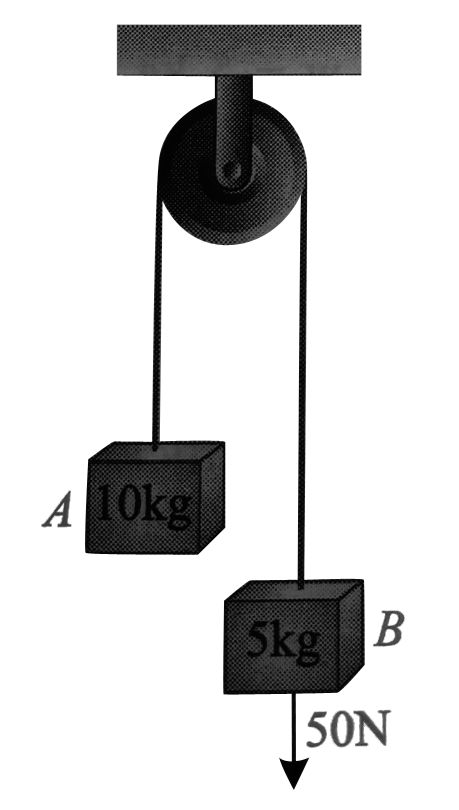A string is used to pull a block of mass m vertically up by a distance h at a constant acceleration g3. The work done by the tension in the string is
23mgh
−mgh3
mgh
43mgh
The correct Answer is:D
To find the work done by the tension in the string while pulling the block of mass m vertically up by a distance h with a constant acceleration of g3, we can follow these steps:
Step 1: Identify the forces acting on the block
The forces acting on the block are:
- The weight of the block, W=mg, acting downwards.
- The tension in the string, T, acting upwards.
Step 2: Apply Newton's second law
Since the block is accelerating upwards with an acceleration a=g3, we can apply Newton's second law:
Fnet=ma
The net force acting on the block can be expressed as:
T−mg=ma
Substituting a=g3:
T−mg=m(g3)
Step 3: Solve for tension T
Rearranging the equation gives:
T=mg+m(g3)
Factoring out mg:
T=mg(1+13)=mg(43)
Thus, the tension in the string is:
T=43mg
Step 4: Calculate the work done by the tension
The work done by a constant force is given by:
W=F⋅d⋅cos(θ)
where F is the force, d is the displacement, and θ is the angle between the force and the displacement. In this case, the tension and the displacement are in the same direction, so θ=0∘ and cos(0)=1.
Thus, the work done by the tension is:
W=T⋅h⋅cos(0)=T⋅h
Substituting the value of T:
W=(43mg)⋅h
Therefore, the work done by the tension in the string is:
W=43mgh
Final Answer
The work done by the tension in the string is 43mgh.
---
The forces acting on the block are:
- The weight of the block, W=mg, acting downwards.
- The tension in the string, T, acting upwards.
Since the block is accelerating upwards with an acceleration a=g3, we can apply Newton's second law:
Fnet=ma
The net force acting on the block can be expressed as:
T−mg=ma
Substituting a=g3:
T−mg=m(g3)
Rearranging the equation gives:
T=mg+m(g3)
Factoring out mg:
T=mg(1+13)=mg(43)
Thus, the tension in the string is:
T=43mg
The work done by a constant force is given by:
W=F⋅d⋅cos(θ)
where F is the force, d is the displacement, and θ is the angle between the force and the displacement. In this case, the tension and the displacement are in the same direction, so θ=0∘ and cos(0)=1.
W=T⋅h⋅cos(0)=T⋅h
Substituting the value of T:
W=(43mg)⋅h
Therefore, the work done by the tension in the string is:
W=43mgh
The work done by the tension in the string is 43mgh.
Topper's Solved these Questions
- WORK, ENERGY AND POWERBOOK - AAKASH INSTITUTE ENGLISHCHAPTER - WORK, ENERGY AND POWEREXERCISE - Assignment (SECTION - B)
35 Videos
- WORK, ENERGY AND POWERBOOK - AAKASH INSTITUTE ENGLISHCHAPTER - WORK, ENERGY AND POWEREXERCISE - Assignment (SECTION - C)
80 Videos
- WORK, ENERGY AND POWERBOOK - AAKASH INSTITUTE ENGLISHCHAPTER - WORK, ENERGY AND POWEREXERCISE - EXERCISE
37 Videos
- WAVESBOOK - AAKASH INSTITUTE ENGLISHCHAPTER - WAVESEXERCISE - ASSIGNMENT ( SECTION-D ( Assertion - Reason Type Questions ))
12 Videos
Similar Questions
A block of mass m tied to a string is lowered by a distance d, at a constant acceleration of g/3. The work done by the string is
View SolutionA block of mass m tied to a string is lowered by a distance d, at a constant acceleration of g/3. The work done by the string is
View SolutionA block of mass m tied to a string is lowered by a distance d, at a constant acceleration of g/3. The work done by the string is
View SolutionA cord is used to lower vertically a block of mass M, a distance d at a constant downward acceleration of g4, then the work done by the cord on the block is
View SolutionA cord is used to lower vertically a block of mass M, a distance d at a constant downward acceleration of g4, then the work done by the cord on the block is
View SolutionA mass M is lowered with the help of a string by a distance h at a distance acceleration g/2. The work done by the string will be
View Solution
Find out the acceleration of the blocks and tensions in the strings.
View Solutionwhen the bob of a simple pendulum swings, the work done by tension in the string is :
View SolutionA block of mass 5kg is being raised vertically upwards by the help of a string attached to it. It rises with an acceleration of 2ms−2. Find the work done by the tension in the string if the block rises by 2.5m. Also find the work done by the gravity and the net work done.
View SolutionA body of mass m is allowed to fall with the help of string with downward acceleration g6 to a distance x. The work done by the string is
View Solution
